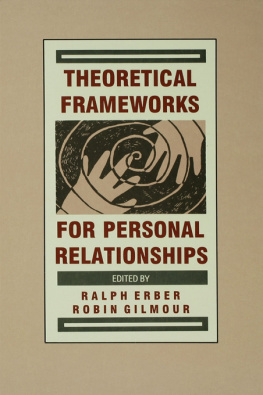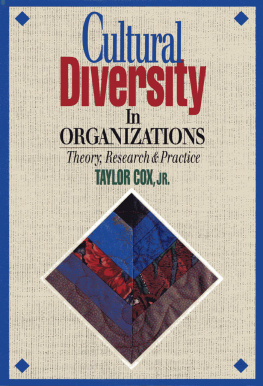
THEORETICAL FRAMEWORKS FOR PERSONAL RELATIONSHIPS
THEORETICAL FRAMEWORKS FOR PERSONAL RELATIONSHIPS
Edited by
Ralph Erber
DePaul University
Robin Gilmour
University of Lancaster

Copyright 1994 by Lawrence Erlbaum Associates, Inc.
All rights reserved. No part of this book may be reproduced in any form, by photostat, microfilm, retrieval system, or any other means, without the prior written permission of the publisher.
Lawrence Erlbaum Associates, Inc., Publishers
365 Broadway
Hillsdale, New Jersey 07642
Library of Congress Cataloging-in-Publication Data
Theoretical frameworks for personal relationships / edited by Ralph Erber, Robin Gilmour.
p. cm.
Includes bibliographical references (p. ) and indexes.
ISBN 0-8058-0573-7 (c : acid-free paper)
1. Interpersonal relations. 2. Man-woman relationships. 3. Intimacy (Psychology). I. Erber, Ralph. II. Gilmour, Robin.
HM132.T45 1994
Books published by Lawrence Erlbaum Associates are printed on acid-free paper, and their bindings are chosen for strength and durability.
Printed in the United States of America
10 9 8 7 6 5 4 3 2 1
This volume is dedicated to Maureen and Brian, my most important personal relationships (RE); to MC and the menagerie (RG); and to George Levinger whose life-long contributions to the area of personal relationships make it possible for both of us to be here today.
Contents
Preface
The past two decades have seen a tremendous increase in research and scholarship devoted to personal relationships. From rather scattered beginnings, a recognizable and recognized field has emerged, whose strength and health is reflected in a wide variety of indicators. At ground level, there is the sheer volume of published journal articles and books. At a second and more organizational level, there is the emergence of two major journals devoted to the field, the International Journal of Personal Relationships and the Journal of Social and Personal Relationships, along with the now firmly established International Society for the Study of Personal Relationships and the long-running series of International Conferences on Personal Relationships. Beyond all this solid evidence there is an interesting form of additional validation in the way many writers, commentators, and editors point out almost as a matter of course how satisfactorily the young field has grown. Indeed, perhaps the most telling sign of all is the fact that dwelling on such an observation is now regarded as hackneyed and trite.
So to use a developmental metaphor, the infant has grown up, the young adult has emerged and is clearly thriving. It is not our intention to go over old ground here. Instead, we wish to pursue the argument a step further by proposing that relationship research has reached a certain stage of maturity that is reflected in the title of this volume. Our contention is that, although the vigor of a field is often shown in the diversity and innovation of its research, it is in the theoretical domain that we find evidence of a real coming of age. The early years of any new scientific endeavor generally require careful empirical work to map out the terrain and its boundaries. Maturity, on the other hand, is characterized by the development of theoretical structures that enable us to consolidate research work to further understand the issues and to give direction to our empirical work.
This volume provides grounds for arguing that the diversity of theorizing is particularly healthy at this point. We believe that it manifests itself in several ways. There is a diversity in the type of issues that were tackled by our contributors, the approaches that were taken, and the disciplinary background from which the different frameworks emerged. , Dykstra and de Jong Gierveld take the rather generic theory of mental incongruity and apply it to the understanding of loneliness among the widowed.
The reader will notice that there is some diversity in terms of how much theory and research is contained in each chapter. Whereas some are purely theoretical, others complement theory with original pieces of empirical research. Finally, the editors and contributors are from different countriesyet another way in which the diversity of this volume manifests itself.
We view the diversity of the frameworks presented in this volume as a strength, as building on established strengths elsewhere to feed into relationship research and enhance its vitality. We believe that each chapter has its own contribution to make to thinking and research about personal relationships. As a group, they add up to an exciting collection that not only reflects a richness of conceptual backing, but also a wide range of usable theoretical structuresusable both in helping us explain relationship phenomena and enabling us to generate additional empirical research.
ACKNOWLEDGMENTS
Numerous people and institutions have helped make this volume possible. We are especially indebted to George Levinger and Sheldon Cotler, the chairpeople of the DePaul University Psychology Department, for their support during the final stages of this project. We also thank Antoinette DAmbrosio, Lucinda Rapp, Nancy Rospenda, Kimberly Ross, Julie Rybarski, and Mark Schuster for providing the backup support for this project, and Maureen Wang Erber for her patience and continued intellectual stimulation.
Ralph Erber
Robin Gilmour
Chapter
Figure Versus Ground: Micro- and Macroperspectives on the Social Psychology of Personal Relationships
George Levinger
University of Massachusetts, Amherst
In this chapter, I examine both micro- and macroaspects of personal relationships, because I believe recent research progress has neglected the influence of broad trends in the sociocultural environment. Social psychological research has usually focused on the figure of pair interaction at the expense of its groundon its immediate or proximal influences, rather than on its distal social determinants. Although personal relations researchers tend to focus narrowly on individuals or close pairs, it is evident that broad social forces affect how people relate to each other, as well as how investigators frame their research problems. Thus, traditional society has stifled studies into interpersonal relations, but modern society encourages such inquiry, which helps people answer questions about a world in flux. Therefore, I attend to the wider context that affects both the study of personal relationships and their phenomena.
This chapter has two main parts. In the first part, I examine how the study of personal relationships developed over the past half century, focusing especially on some of my own ideas and research on this topic. In the second part, I consider several recent microanalytic analyses of dyadic interaction and relationship, and then contrast their emphases with macroanalytic appraisals of social structural influences on relationships in our culture, after which I discuss some interconnections between micro- and macroapproaches.
DIALECTIC TENSIONS
To set the backdrop to my discussion, let me begin with some dialectic images from Raushs (1977) reflections on the first published conference on the topic of close relationships, held in 1974 (Levinger & Raush, 1977). Reviewing what the contributors had said, Raush wrote about the dialectic tensions among the personal, interpersonal, and societal orientations to relationships. He suggested that these different orientations are frames through which both outside observers and inside participants view relationships (Raush, 1977). For instance, he reviewed the changing conceptions of intimacy over a 300-year span of U.S. history. To capture those changes, he employed the metaphor of the dance. Talking about the Colonial Era in America 300 years ago, Raush saw couples performing a set dance pattern in the context of the group: Couples join and separate, but the pattern is fixed and it is the community that surrounds and controls the dance. Individual skill and grace may be called for but never individual self-expression (p. 179). In the Jacksonian Era, 150 years later, the formalities of popular dance structures begin to disintegrate. The dance caller appears for the first time. The once fixed sequence of patterns is no longer given communally, and it is the caller who sets the sequence (p. 180). Still later, in the early 20th century, the dance becomes that of a couple as the unit. Each couple dances in close physical contact, apart from other couples, and with little or no sense of social community. The male leads, the female follows. The dance steps, however, are patterned to the music, and some elements of a formal sequence are maintained (p. 181). Finally today, or in the 1970s when Raush was writing, the formation is still one of pairs, and the music provides the background. [But T]here is no defined sequence of steps; the partners are in minimal and momentary contact with each other, and each does as he or she wishes; the emphasis is on individual autonomy while meeting in transit (p. 183). However, Raush noted that there have been recent countertrends, as in the revival of folk dancing and even ballroom dancing among both older and younger people.
Next page






